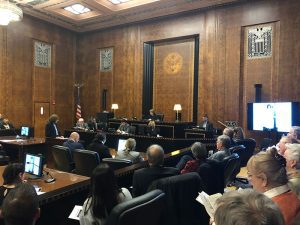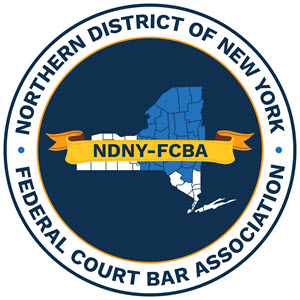More than 200 people packed into the Ceremonial Courtroom of the James T. Foley U.S. Courthouse on the evening of November 12, to watch the re-enactment of one of the most infamous trials in U.S. history – the 1951 espionage trial of Ethel and Julius Rosenberg.
 The Rosenberg trial was the third annual reenactment organized by the FCBA and directed by United States District Judge Mae A. D’Agostino. A catered reception, on the Courthouse’s first floor, followed the 90-minute reenactment.
The Rosenberg trial was the third annual reenactment organized by the FCBA and directed by United States District Judge Mae A. D’Agostino. A catered reception, on the Courthouse’s first floor, followed the 90-minute reenactment.
During the height of the Cold War, Julius and Ethel Rosenberg, husband and wife, were charged with spying for the Soviet Union and passing along information that helped the Soviets build the atomic bomb. A three-week trial occurred in March-April 1951, in the United States District Court for the Southern District of New York, and ended in guilty verdicts. Judge Irving Kaufman sentenced the Rosenbergs to death on April 5, 1951, and the Rosenbergs were executed by electric chair on June 19, 1953. The Second Circuit’s Justice for All education initiative, which created the script for the reenactment, maintains a web page devoted to the case, available here.
The reenactment focused on the trial’s flaws, including the Government’s decision not to provide defense counsel with the inconsistent grand jury testimony of trial witnesses; Ethel Rosenberg’s invocation of her Fifth Amendment rights in front of the jury; and unqualified defense counsel. Today, as the reenactment made clear, the Government must provide defense counsel with the grand jury testimony of testifying witnesses, a jury would not hear a defendant invoke her right against self-incrimination, and defense counsel in a federal death penalty case would be highly experienced. “The law has changed quite a bit since this trial,” Judge D’Agostino told the audience.
The reenactment also highlighted the love between Ethel and Julius, and Ethel’s betrayal at the hands of her own brother, David Greenglass, a cooperating defendant who was the Government’s star witness and gave trial testimony that conflicted with his grand jury testimony. The play ended, poignantly, with the playing of an opera aria that Ethel had sung to Julius.
For the Albany reenactment, judges, lawyers and Albany Law School students served as cast members. Court staff and security officers were also instrumental to the event’s success.
Attorney Norah Murphy played Ethel Rosenberg, and law student Alicia Johnson portrayed Julius.
United States Magistrate Judge Thérèse Wiley Dancks and United States Bankruptcy Judge Robert E. Littlefield, Jr. served as the narrators. Justice Elizabeth Garry, who presides over the New York State Supreme Court Third Department, played Judge Kaufman. United States Attorney Grant C. Jaquith portrayed the prosecutor, Irving H. Saypol.
United States Magistrate Judge Daniel J. Stewart photographed the event.
In an interview following the event, Judge D’Agostino said one goal of the reenactment was to get people more interested in the legal process, and that many people came up to her after the event wanting to know more about the trial. Judge D’Agostino praised the script for being able to summarize a 3-week trial in 90 minutes, and the actors for being so well-prepared.
The Rosenberg trial reenactment will be coming to Syracuse on March 12.

